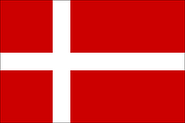From the time of Vikings, there was a fishing village called Havn ("harbor"... original, I know) located at the site of modern Copenhagen. It came into the possession of Bishop Absalon who fortified it in 1167 which is generally regarded as the foundation of Copenhagen. In 1254 it received its charter as a city under Bishop Jakob Erlandson. Copenhagen is located at the most important entrance to the Baltic Sea and the rich towns of the Hanseatic League, which had the unfortunate effect of causing it be to attacked frequently. In 1416, Eric of Pomerania took control of the city and it henceforth belonged to the Danish crown.
 Despite the attacks, Copenhagen continued to grow, and in 1479 the University of Copenhagen was founded.In 1596, Christian IV decided he wanted to make Copenhagen the economic, military, religious, and cultural center of the Nordic region. He made many mercantilist reforms and added two new districts to the city, Nyboder and Christianshavn, the latter being modeled after Amsterdam. He also increased the fortification of the city.
Despite the attacks, Copenhagen continued to grow, and in 1479 the University of Copenhagen was founded.In 1596, Christian IV decided he wanted to make Copenhagen the economic, military, religious, and cultural center of the Nordic region. He made many mercantilist reforms and added two new districts to the city, Nyboder and Christianshavn, the latter being modeled after Amsterdam. He also increased the fortification of the city. The next several centuries saw a series of assaults, fires, and plagues, followed by rebuilding and growth. The population grew rapidly starting around 1800. During World War II, Copenhagen was occupied by German troops along with the rest of the country. For the first several years, Denmark was allowed a relative degree of autonomy. Over time, tensions grew and in August 1943 the Germans dissolved the Danish government and declared martial law. The Nazis tried to eliminate all Jews from Denmark, but almost all of them were smuggled out of Denmark to Sweden. Finally in May 1945 Copenhagen and most of Denmark was liberated from German rule by Bernard Montgomery.
The next several centuries saw a series of assaults, fires, and plagues, followed by rebuilding and growth. The population grew rapidly starting around 1800. During World War II, Copenhagen was occupied by German troops along with the rest of the country. For the first several years, Denmark was allowed a relative degree of autonomy. Over time, tensions grew and in August 1943 the Germans dissolved the Danish government and declared martial law. The Nazis tried to eliminate all Jews from Denmark, but almost all of them were smuggled out of Denmark to Sweden. Finally in May 1945 Copenhagen and most of Denmark was liberated from German rule by Bernard Montgomery.Since the war, Copenhagen has grown significantly. The Oresund Bridge connecting Copenhagen and Malmö was completed in 2000, and the Copenhagen Metro was opened for traffic in 2002. In June 2007, I will visit Copenhagen, ushering in a new era of prosperity and cultural flourishing.

No comments:
Post a Comment